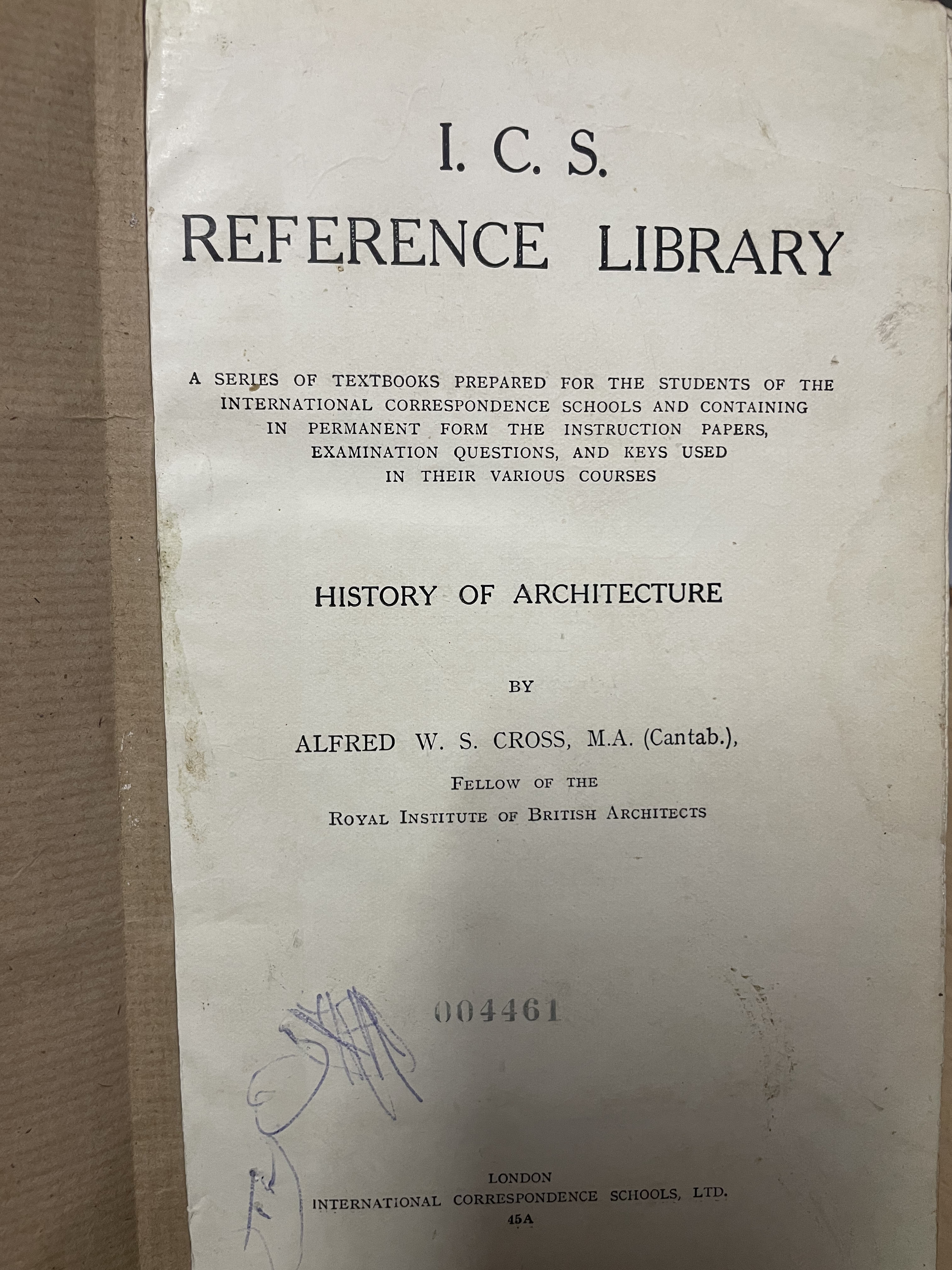History of Architecture

About
Summary
Exquisite
TOC
Details
Related
URL
Images
Overview
History of Architecture by Alfred W.S. Cross, part of the I.C.S. (International Correspondence Schools) Reference Library series, provides a structured overview of architectural styles throughout history. Given that it was part of a correspondence course, the book likely focuses on clear explanations and well-organized content to facilitate remote learning.
Importance of Book
Structured Learning: As part of the I.C.S. Reference Library, the book would provide a structured and systematic approach to learning about architectural history, making it accessible to students and self-learners.
Comprehensive Coverage: The book would offer a broad overview of architectural styles and movements from ancient times to the early 20th century, providing a solid foundation for further study.
Visual Aids: The book would likely include numerous illustrations, diagrams, and photographs to help readers visualize and understand different architectural styles and techniques.
Practical Knowledge: As a textbook for a correspondence course, the book would likely emphasize practical knowledge and skills, such as architectural drawing, terminology, and analysis.
Historical Context: It would place architectural developments within their social, cultural, and technological contexts, helping readers to understand the forces that have shaped the built environment.
Key Themes
The Evolution of Style: The book would trace the evolution of architectural styles over time, showing how different styles have emerged, evolved, and influenced each other.
The Relationship Between Form and Function: It would explore the relationship between architectural form and function, examining how buildings are designed to meet specific needs and purposes.
The Impact of Technology: The book would highlight the impact of technology on architectural design and construction, showing how new materials and methods have transformed the built environment.
The Influence of Culture: It would emphasize the influence of culture on architectural expression, showing how buildings reflect the values, beliefs, and aspirations of the societies that create them.
Cultural Significance
Preservation of Cultural Heritage: The book would contribute to the preservation of cultural heritage by documenting and celebrating the architectural achievements of different societies throughout history.
Promotion of Cultural Understanding: It would promote cultural understanding by showcasing the diversity of architectural traditions around the world.
Inspiration for Creativity: The book would inspire creativity by exposing readers to a wide range of architectural styles and design ideas.
Enhancement of Aesthetic Appreciation: It would enhance aesthetic appreciation by teaching readers how to analyze and interpret buildings and spaces.
Effects on Society
Education and Professional Development: The book would contribute to the education and professional development of architects, designers, and other building professionals.
Informed Citizens: The book would create more informed citizens who are knowledgeable about the built environment and its impact on their lives.
Better Design Decisions: It would empower individuals and communities to make better design decisions, whether in their own homes or in the public realm.
Greater Appreciation for Architecture: The book would foster a greater appreciation for architecture as an art form and a cultural expression.
Preservation of Historic Buildings: It would encourage the preservation of historic buildings and sites, recognizing their importance as part of our shared heritage.
Conclusion
History of Architecture by Alfred W.S. Cross, as part of the I.C.S. Reference Library, provides a structured and comprehensive overview of architectural history. It is of value as a teaching tool, it highlights key themes, its cultural significance, and its effect on the country and society.
Table of Content
The 1921 edition of History of Architecture by W. S. Cross likely includes a detailed exploration of architectural development through various historical periods. While I don\'t have the exact table of contents, a typical table of contents for such a book might look like this:Table of Contents
IntroductionOverview of architectural history and the scope of the book.
The importance of studying architecture in historical context.
Ancient ArchitectureEgyptian Architecture:
Key structures and architectural techniques in ancient Egypt.
Mesopotamian Architecture:
Architecture of ancient Mesopotamia, including ziggurats and palaces.
Greek Architecture:
Classical Greek architecture, including temples and public buildings.
Roman Architecture:
Roman innovations such as arches, aqueducts, and monumental structures.
Medieval ArchitectureEarly Christian Architecture:
Development of basilicas and early Christian churches.
Byzantine Architecture:
Features of Byzantine architecture, including domes and mosaics.
Romanesque Architecture:
Characteristics of Romanesque style, including churches and castles.
Gothic Architecture:
Key elements of Gothic architecture, such as pointed arches, ribbed vaults, and flying buttresses.
Renaissance ArchitectureEarly Renaissance:
Beginnings of Renaissance architecture, including key figures and their contributions.
High Renaissance:
Major achievements and masterpieces of the High Renaissance period.
Mannerism:
The transition from Renaissance to Baroque and the characteristics of Mannerist architecture.
Baroque and Rococo ArchitectureBaroque Architecture:
Key features and examples of Baroque architecture, including churches and palaces.
Rococo Architecture:
Characteristics of Rococo style and its decorative elements.
19th Century ArchitectureNeoclassicism:
Revival of classical styles in the 19th century and its impact on architecture.
Victorian Architecture:
Various styles within Victorian architecture, including Gothic Revival and Italianate.
Industrial Revolution:
Influence of industrialization on architectural design and construction techniques.
Early 20th Century ArchitectureBeaux-Arts Architecture:
Characteristics and examples of the Beaux-Arts style.
Modern Architecture:
Early developments in modern architecture, including the International Style and Bauhaus.
ConclusionSummary of key trends and changes in architectural history.
Reflections on the future of architecture.
Title
History of Architecture
Author
Alfred W S Cross
Name of Publisher
International Correspondence Schools London
Publish Date
1921
Subject
Comprehensive examination of architectural history
Vintage
1901-1947
Category
Language/ Art
Sub Category
Social Sciences
Rarity
RARE
